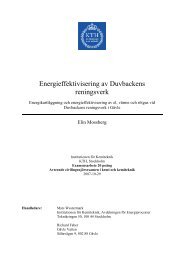Problematik vid höga flöden - Gästrike Vatten AB
Problematik vid höga flöden - Gästrike Vatten AB
Problematik vid höga flöden - Gästrike Vatten AB
You also want an ePaper? Increase the reach of your titles
YUMPU automatically turns print PDFs into web optimized ePapers that Google loves.
ENHANCED BIOLOGICAL PHOSPHORUS REMOVAL AND PRIMARY SLUDGE<br />
HYDROLYSIS DURING HIGH-FLOW CONDITIONS: THE RESULT OF THREE YEARS<br />
FULL-SCALE EXPERIENCES AT DUVBACKEN WASTE WATER TREATMENT PLANT<br />
J. Örnmark<br />
Master Thesis in Engineering Chemistry, Umeå University, Sweden<br />
<strong>Gästrike</strong> <strong>Vatten</strong> <strong>AB</strong>, Box 954, SE-801 33 Gävle, Sweden<br />
<strong>AB</strong>STRACT<br />
Enhanced biological phosphorus removal (EBPR) is a well-established technology for the<br />
treatment of municipal wastewater without the use of chemical precipitation. The method is<br />
being applied at Duvbacken wastewater treatment plant since 2004, where it gives an<br />
approximate 95 % reduction of the affluent phosphorus during normal operating conditions.<br />
However, after long periods with high water flows and low organic loadings, the process has<br />
been known to deteriorate leading to increased effluent phosphorus concentrations and a need<br />
for chemical precipitation.<br />
This report is the result of three years full-scale operation and optimization experiences with<br />
EBPR at the Duvbacken wastewater treatment plant. The result includes an identification of<br />
critical parameters responsible for the process failure during high-flow and low organic<br />
loading conditions. Full-scale measures were conducted including an operating strategy for<br />
the process during, and after, high-flow conditions. The results were found to be successful<br />
leading to a more stable process, less effluent peaks, minimal usage of precipitation chemicals<br />
and a lower energy consumption.<br />
Keywords: Enhanced biological phosphorus removal (EBPR), volatile fatty acids (VFA),<br />
primary sludge hydrolysis, phosphate-accumulating organisms (PAO), excessive aeration,<br />
aeration control, low loading, high-flow conditions, phosphate uptake, phosphate release<br />
INTRODUCTION<br />
Enhanced biological phosphorus removal (EBPR) is a well-established technology for the<br />
treatment of municipal wastewater without the use of chemical precipitation. This is achieved<br />
by specific types of bacteria; phosphorus accumulating organisms (PAO). These naturally<br />
occurring bacteria are enriched in the activated sludge by introducing an anaerobic reactor<br />
upstream of the aerobic reactor in an activated sludge treatment system. The specific plant<br />
operating conditions favour PAO that have the ability to accumulate organic substrates during<br />
anaerobic conditions, and therefore gain advantages over other heterotrophic organisms. The<br />
bacteria also have an ability to store phosphorus during aerobic conditions, to a higher extent<br />
than what is needed instantly, and this is the key mechanism in the EBPR process which leads<br />
to a phosphate removal from the bulk liquid phase.<br />
The microbiologically available organic substrates for PAO consist solely of volatile fatty<br />
acids (VFA) (Comeau et al., 1986, Mino et al., 1987) that are fed to the anaerobic reactor by<br />
the wastewater. VFA are stored in carbon reserves in the cell as poly-hydroxyl-alconates<br />
(PHA) while energy and reduction equivalents are pro<strong>vid</strong>ed by the break down of<br />
accumulated polyphosphate (poly-P) and glycogen (Seviour et al., 2003) . Subsequently,<br />
under aerobic conditions, the stored carbon favors growth and accumulation of phosphate by<br />
PAO, which are capable of dual poly-P and carbon storage. High phosphate removal<br />
53






